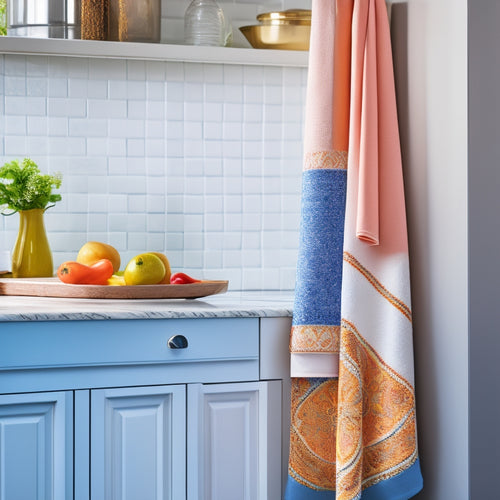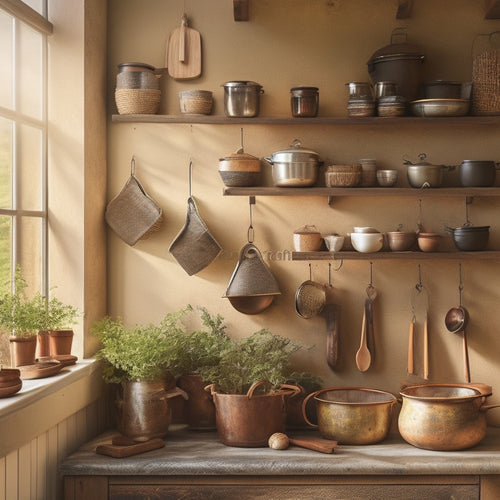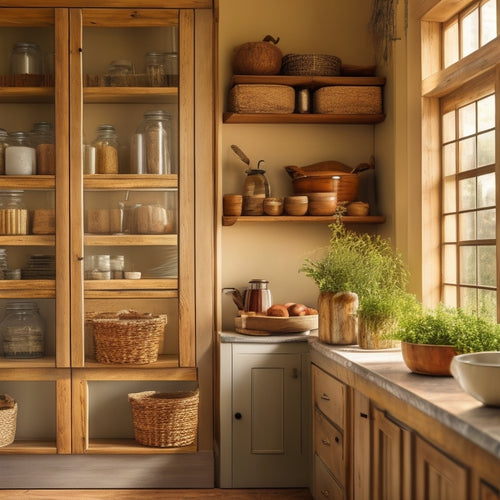
Why Do Kitchen Cabinets Waste So Much Space?
Share
You're likely unaware that traditional kitchen cabinets are designed with a flawed assumption: that your storage needs will fit neatly within the confines of their rigid dimensions. This outdated approach leads to wasted space, cramped shelves, and cluttered countertops. From unused vertical storage to inefficient shelf configurations, poorly utilized back walls, and obstructive corner cabinets, it's time to rethink traditional design. You're not alone in feeling frustrated by the lack of functionality and aesthetics in your kitchen. Imagine a space where every inch is optimized for beauty and purpose - what would you discover if you looked closer?
Key Takeaways
• Traditional cabinet designs often waste space due to inefficient layouts, poor shelf configuration, and neglected areas like corner cabinets and back walls.
• Inadequate use of vertical storage potential above cabinets leads to cluttered countertops and shelves, reducing overall kitchen functionality.
• Cabinet depth limitations and fixed shelf configurations hinder storage capacity, making it difficult to organize items like pots and pans efficiently.
• Corner cabinets are notorious for their tricky angles and hard-to-reach depths, making them a common space-wasting culprit in kitchen design.
• Poorly utilized back wall areas in kitchens represent a significant missed opportunity for functional storage solutions, such as pegboards or magnetic strips.
Traditional Cabinet Design Flaws
In nearly every kitchen, traditional cabinet designs waste precious space, forcing you to navigate a labyrinth of narrow shelves and deep, dark recesses just to find that one elusive spice jar. You're not alone in this frustration.
The door swing problem is a major culprit, where cabinet doors open outward, taking up valuable floor space and making it difficult to move around the kitchen. This outdated design flaw not only hampers your workflow but also creates an unsightly visual obstacle.
Furthermore, traditional cabinets often feature unusable top space, leaving valuable real estate above the cabinets collecting dust. This is particularly true for corner cabinets, where the space above is often inaccessible and impractical.
A well-designed kitchen should prioritize functionality and aesthetics. By acknowledging these traditional design flaws, you can start to envision a more efficient, visually appealing space that serves you and your loved ones.
It's time to rethink the traditional cabinet design and create a kitchen that truly serves.
Wasted Vertical Storage Potential
You're likely staring up at a sea of unused vertical space above your cabinets, wondering why it's not being utilized to maximize your kitchen's storage potential. This wasted space is a common issue in many kitchens, and it's a shame because it could be used to store infrequently used items, keeping your countertops and main shelves clutter-free.
By incorporating vertical organization, you can make the most of this space and create a more streamlined kitchen.
Imagine installing floor-to-ceiling shelves or storage units that take advantage of the entire vertical space. This wouldn't only increase storage capacity but also create a sleek, modern aesthetic. Storage optimization is key here, as you'll want to make certain that the items you store are easily accessible and not too heavy for the upper shelves.
Inefficient Shelf Configuration Issues
About 75% of kitchen cabinets suffer from inefficient shelf configuration. This means you're stuck with cramped, cluttered, or hard-to-reach storage spaces that drive you crazy. It's frustrating, especially when you're trying to create a beautiful, functional kitchen that serves your family and friends.
The root of the problem lies in poor shelf organization, hindering your ability to maximize space. When shelves are too narrow, too wide, or awkwardly spaced, they create pockets of wasted space that make it difficult to store items efficiently. This leads to cluttered countertops, overflowing pantries, and a general sense of disorganization.
To combat this, consider a cabinet layout that prioritizes efficient design. Adjustable shelves, slide-out drawers, and customizable compartments can help you create a tailored storage system that meets your unique needs. By optimizing your shelf configuration, you'll be able to store more, stress less, and create a kitchen that's both beautiful and functional.
Cabinet Depth Challenges Explained
As you plan your kitchen cabinet layout, be mindful of the cabinet depth, which can quickly become a major roadblock to efficient storage if not carefully considered.
Depth limitations can lead to wasted space, making it difficult to store items like pots, pans, and appliances. To overcome these challenges, consider storage solutions that maximize vertical space, such as pull-out shelves or adjustable storage bins. These space-saving hacks can help you make the most of your cabinet's depth, keeping frequently used items within easy reach.
When designing your cabinet layout, think about the items you need to store and how you can optimize the space to accommodate them. For example, consider installing a utensil organizer or a spice rack to keep clutter at bay.
Organization tips like these can help you create a more functional and aesthetically pleasing kitchen. By carefully planning your cabinet layout and incorporating smart storage solutions, you can create a kitchen that serves you and your loved ones, rather than the other way around.
Obstructive Corner Cabinet Space
Corner cabinets can be infamous space-wasters, with their tricky angles and hard-to-reach depths, leaving you to struggle with awkwardly placed items and wasted square footage. You're not alone in this frustration. Many homeowners struggle to maximize the potential of these tricky corners.
But, what if you could turn these dead zones into functional hubs? By embracing corner cabinet alternatives, you can reveal the full potential of your kitchen. Consider installing a carousel or lazy Susan, allowing you to access items with ease. Alternatively, opt for a pull-out shelf or drawer, providing a seamless change between storage and countertop space.
These space-saving solutions will have you wondering how you ever managed without them. By rethinking the way you approach corner cabinet design, you can create a more efficient, visually appealing kitchen that serves you and your loved ones. Say goodbye to clutter and hello to a more harmonious cooking environment.
Poorly Utilized Back Wall Area
You often neglect the back wall area, leaving it to collect dust and redundant decorations, when it could be transformed into a sleek, functional hub that streamlines your kitchen workflow. By incorporating back wall solutions, you can create a seamless cooking experience that's both aesthetically pleasing and efficient.
Consider installing a pegboard or a magnetic strip to hang frequently used utensils, pots, and pans, keeping them within easy reach. This not only frees up cabinet space but also adds a touch of modern sophistication to your kitchen.
You can also utilize the cabinet backs to maximize space. Add a spice rack, a knife block, or a built-in trash can to keep your countertops clutter-free. Creative alternatives like a fold-down table or a hidden message center can also be incorporated to enhance the functionality of your kitchen.
Frequently Asked Questions
Can I Customize My Kitchen Cabinets to Fit My Specific Needs?
You can totally customize your kitchen cabinets to fit your specific needs! Explore various customization options to optimize space, ensuring a seamless flow and aesthetic appeal that serves you and your loved ones beautifully.
How Do I Measure My Kitchen Space for Optimal Cabinet Design?
You'll create a best cabinet layout by measuring your kitchen space carefully, considering corner spaces, and identifying areas for efficient storage solutions, ensuring a harmonious blend of form and function in your dream kitchen.
Are There Any Eco-Friendly or Sustainable Cabinet Material Options?
Imagine a serene forest, where trees thrive in harmony. You're likely seeking cabinet materials that mirror this balance. Consider eco-friendly options like bamboo cabinets, which boast sustainable harvesting, or recycled wood cabinets, crafted from reclaimed treasures, to bring harmony to your kitchen design.
Can I Install Kitchen Cabinets Myself, or Do I Need a Professional?
You're considering DIY vs professional installation for your eco-friendly cabinets. While pros offer customization options and space optimization techniques, DIY can save you money, but may compromise on durability and aesthetics, impacting the environmental cost of disposal.
How Often Should I Replace or Update My Kitchen Cabinets?
You'll want to replace or update your kitchen cabinets every 10-15 years, considering cabinet longevity and budget constraints, to maintain a visually appealing, functional space that serves others with ease and efficiency.
Related Posts
-

Over-The-Door Kitchen Towel Holder
An over-the-door kitchen towel holder is a smart way to maximize your space while keeping towels easy to grab. It hoo...
-

Wall-Mounted Racks for Kitchen Tool Storage
Wall-mounted racks are perfect for maximizing storage in your kitchen. By utilizing vertical space, you can free up u...
-

Freestanding Pantry Units for Farmhouse Kitchen Style
Freestanding pantry units perfectly blend beauty and function in your farmhouse kitchen. They maximize storage while ...


